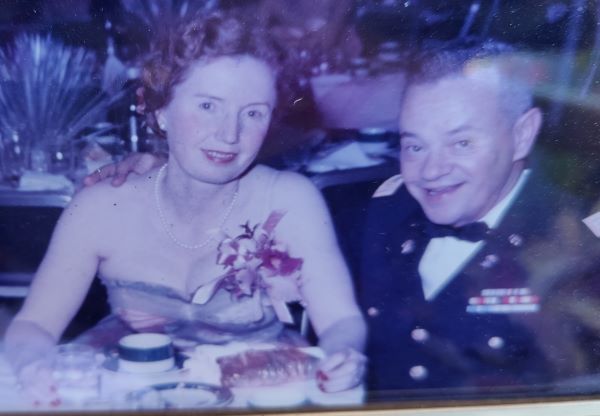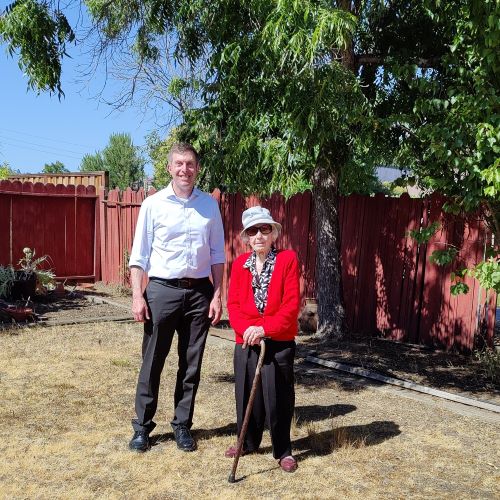by Buck Institute
July 26, 2021 . Profile
Marin’s oldest resident keeps on shining!
In memory of Pauline Angleman who passed away in October 2021.
We double-dare you not be inspired by this story:
As Marin County’s oldest resident, 112-year-old Pauline Cheves Angleman grew up before penicillin, polio, pantyhose, dishwashers and ball point pens. She was ten years old when the Spanish flu infected a third of the world’s population, and remembers the home remedies her mother used to try to keep her and her siblings healthy in a world before mRNA vaccines.
A celebrity in Corte Madera, Pauline is used to getting attention. She often leads community parades and her birthday celebrations make the local newspapers. She has files of congratulatory letters from local and state politicians. A letter from Barack and Michelle Obama acknowledging her 107th birthday hangs on her living room wall.
Pauline recently got some additional attention from Buck faculty member John Newman, MD, PhD, who visited with her at her home. Dr. Newman runs a Buck lab focused on developing treatments for geriatric syndromes of aging; he is also geriatrician who cares for older adults at the San Francisco VA hospital. He was happily amazed at the state of Pauline’s health, saying his jaw dropped as he watched her spring up from the lawn chair she was sitting in as they chatted on her porch. “It’s remarkable how independent she is. Pauline is amazingly functional, vibrant, and alive. I never would have guessed that she was 112. She's stronger and more active than most people who are 30 years younger.”
Widowed for 30 years, Pauline lives alone. She takes care of her 3-bedroom house, and does her own yard work, which includes climbing a 6-foot ladder to pick fruit in her back yard. “I just refuse to spend too much time sitting in a chair or lying in bed,” she says. “I like to keep busy and I like to keep moving.” (She is known for zipping around the local Safeway while shopping for groceries.) Pauline takes eye drops for glaucoma and occasionally uses an over-the-counter remedy for leg cramps. “That’s it,” she says, adding emphatically “medicines will kill you.” Depending on which list you look at, she is the 11th oldest person in the United States.
Pauline describes her childhood as idyllic. The middle child of seven siblings, she grew up as a farmer’s daughter on a homestead ranch in Oklahoma where she rode a pony to school during inclement weather. None of her brothers or sisters was particularly long-lived. She has no idea why she has lived so long, saying, “Sometimes I think I just forgot to die.” It’s not a bad strategy.
Studying super-agers: Is there something in it for all of us?
Researchers studying the aging process hope to find the “special sauce” that allows super-centenarians like Pauline to avoid chronic diseases of aging and stay healthy and independent. While studies show that there is a genetic component to long life, Newman says there is no single “healthy aging” gene. Instead there may be a constellation of genetic variants, such as those in the IGF and insulin-signaling pathway that show up in centenarians, along with variants that lower the risk for Alzheimer’s disease. Newman adds that most geriatricians think the focus on genetics is a bit overblown, “By the time you get to 80, 90 or 100, the effects of your life experiences over that time outweigh the genetics you were born with. The next frontier is looking at epigenetics which involves studying how a cumulative lifetime of exposures and experiences affect your systems over the long term. I suspect that centenarians have a lot to teach us about that.”
Newman says studies show many super-centenarians do share two common personality traits – a great attitude coupled with determination. “When I asked Pauline what she hopes medicine could do for her, what she would change if she could, I loved that she straightened up, looked me in the eye, and replied ‘There is nothing wrong with me’. That’s part of that attitude. People who successfully age say, ‘There’s no reason why I shouldn’t keep doing what I’m doing until I physically can’t. And when that happens I’ll do different things.’ ”
Living a long life: It may be all about resilience
Newman says there are likely both genetic and personality traits linked to the bounce-back resilience that is common among super-centenarians. “Resilience is one of the biggest factors which sets us up for aging well,” he says, noting that Pauline recently had an infection in her leg which could have taken her down. “With the right treatment she recovered from it – it wasn’t a big deal for her. But it was the sort of thing that, even with the right treatment, many older adults might not have been the same afterwards – weaker, having a hard time walking, maybe still confused from a bout of delirium in the hospital. Not her. I would never have guessed she recently overcame that. Maybe there is something medicine can learn from Pauline and others like her that can help, for example, frail 80-year-olds recover from hip fractures better.” (Jeanne Calment, the French woman who famously lived to 122, fractured her leg when she was 100 but recovered quickly and was able to walk again.)
 Newman says the fact that Pauline’s life has not lacked for stimulation and social interaction probably factors into her longevity. She moved to California on her own and got married at 29 to an Oklahoma beau who followed her to the west coast. Her husband Louis joined the army in 1942 and served for 20 years before retiring as a Lt. Colonel. Stationed in Japan before and during the Korean War, the couple, who had no children, traveled extensively throughout and beyond Asia, quickly becoming world travelers. Avid bridge players, they bought their house new in 1958; it is filled with furniture and mementos from their travels. Louis succumbed to Alzheimer’s in 1990 after 53 years of marriage. Eight-two when her husband died, Pauline did not slow down. She went on numerous excursions with friends and family members; today she easily recounts the adventures through Europe, Egypt, Russia, Australia, New Zealand, and Yugoslavia that went on into her 10th decade.
Newman says the fact that Pauline’s life has not lacked for stimulation and social interaction probably factors into her longevity. She moved to California on her own and got married at 29 to an Oklahoma beau who followed her to the west coast. Her husband Louis joined the army in 1942 and served for 20 years before retiring as a Lt. Colonel. Stationed in Japan before and during the Korean War, the couple, who had no children, traveled extensively throughout and beyond Asia, quickly becoming world travelers. Avid bridge players, they bought their house new in 1958; it is filled with furniture and mementos from their travels. Louis succumbed to Alzheimer’s in 1990 after 53 years of marriage. Eight-two when her husband died, Pauline did not slow down. She went on numerous excursions with friends and family members; today she easily recounts the adventures through Europe, Egypt, Russia, Australia, New Zealand, and Yugoslavia that went on into her 10th decade.
“What’s great about Pauline is that she reminiscences with joy,” says Newman. “She doesn’t focus on losses. She talks about phases in her life, she doesn’t feel sorry for herself.”
Partial to the military, Pauline was president of the local American Legion Auxiliary for 12 years before stepping down when she was 103. When she was 110, she fell and cracked her pelvis, staying in the hospital for a month. While in PT, the therapist accidentally wrenched her knee resulting in the need for a cane or walker. Shortly thereafter, Pauline voluntarily, albeit reluctantly, stopped driving.
 Before the pandemic, she was a regular at events and programs offered for seniors at Whistlestop (now Vivalon). Today, she stays engaged with the world. She watches the evening news, follows politics and is a huge fan of the show 60 Minutes. She enjoys spending time in her yard (the pecan tree in the photo started out as a sapling brought back from a trip to Oklahoma) and visiting with neighbors who regularly check in with her.
Before the pandemic, she was a regular at events and programs offered for seniors at Whistlestop (now Vivalon). Today, she stays engaged with the world. She watches the evening news, follows politics and is a huge fan of the show 60 Minutes. She enjoys spending time in her yard (the pecan tree in the photo started out as a sapling brought back from a trip to Oklahoma) and visiting with neighbors who regularly check in with her.
Back to attitude and simple pleasures
Newman says his goal is to help people be more like Pauline, to live joyful and independent lives as long as they can. “Geroscience to me is not 'I want to be 30 forever and be immortal.’ It’s about helping people overcome the challenges that aging can bring to continue living vibrant, meaningful, dignified lives at every stage of life. Pauline embodies the opposite of ageism,” says Newman. “Getting older just gave her more opportunities to do what she wanted to do. I love that Pauline knows that there is nothing wrong with her, that there's nothing wrong with getting old. Getting old is good; it can come with challenges, but we can help people deal with them.”
Beyond staying active (and not taking much medicine) Pauline advises older adults to drink plenty of water and lay off of processed junk food. She loves orange juice and relishes her daily breakfast of bacon and an egg, sandwiched between buttered toast and grape jelly. Asked about her diet, Newman says, “Sounds yummy to me.”
Science is showing that while chronological aging is inevitable, biological aging is malleable. There's a part of it that you can fight, and we are getting closer and closer to winning that fight.
Eric Verdin, MD, Buck Institute President and CEO